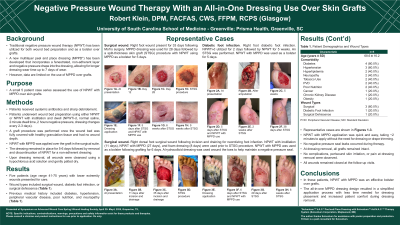Case Series/Study
(CS-073) Negative Pressure Wound Therapy with an All-in-one Dressing Use over Skin Grafts

Methods:
Patients received systemic antibiotics and sharp debridement as needed. Prior treatment included NPWT or NPWT with instillation for wound bed preparation. A graft procedure was performed once the wound bed was fully covered with healthy granulation tissue and had no wound depth. NPWT with MPPD was applied over the graft in the surgical suite. Dressings remained in place for 5 days followed by removal and discontinuation of NPWT. Once the dressing was removed, the area was cleansed with hypochlorous solution and gently patted dry.
Results:
Four patients (age range: 41-75) with lower extremity wounds presented for care. Previous medical history included diabetes, hypertension, peripheral vascular disease, poor nutrition, and neuropathy. Wound types included surgical dehiscence (n=2), open surgical wound (n=1), or diabetic foot infection (n=1). NPWT with MPPD application was quick and easy, taking only approximately 2 minutes to apply without the need for dressing or drape trimming. No negative pressure seal leaks occurred during therapy. At dressing removal, all grafts remained intact. No complications, periwound irritation, or pain at dressing removal were observed. All wounds remained closed at the follow-up visits.
Discussion:
In these patients, NPWT with MPPD was an effective bolster over grafts. The all-in-one MPPD dressing design resulted in a simplified dressing application process with less time needed for dressing application and increased patient comfort during dressing removal.

.jpg)
